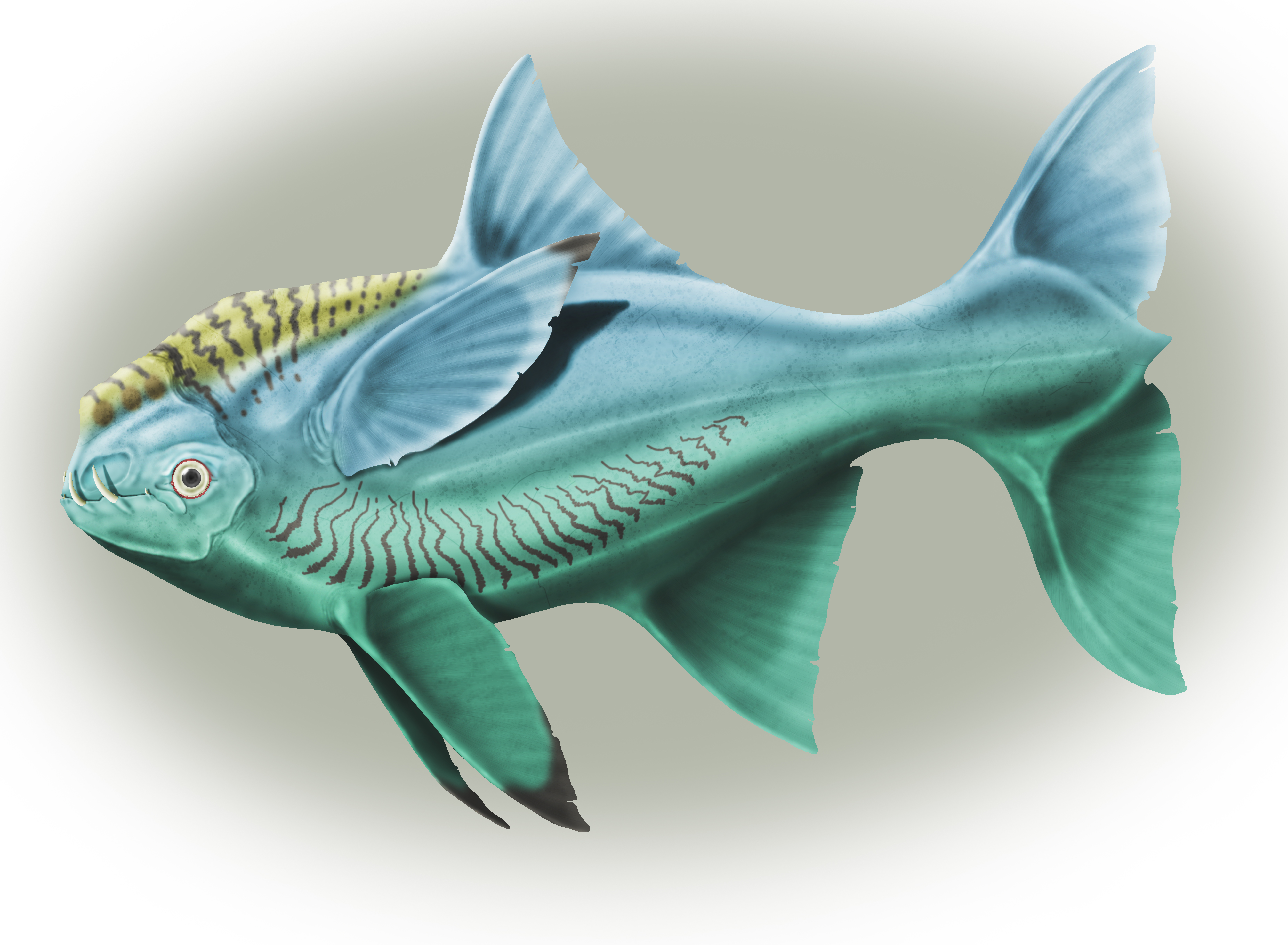Striped Innunawi
Heterodontomorsus lakaii is a medium sized Tynioninae Sogerid Amphibian found living from the Iron-mussel reefs of the south Irobian Ocean to the west Union Kelp Forest.
The animal lives in small schools swimming in close proximity with eachother near the seabed or at medium depths; a normal school of H. lakaii is composed by four to five females and two males, rarely a school will have only one male.
It feeds on shelled invertebrates like Iron-Mussels, Flowering shells and Sealers, crushing their shells with its strong bite and the rounded internal teeth, which can exsert extreme strength on the robust shell of its prey.
The four display teeth outside the mouth are used for sexual selection between males, which have the more developed ones between the two genders.
Living in much closer proximity to the shores compared to the @Eneas , the western populations suffered heavily from the competition with the latter over some overlapping prey items in their diets.
The eastern population is by far the most abundant, with a more greenish tint, the Kelp forest inhabiting subspecies is more adapted to hunt the local Flowering shells and Sealers, a much less contested food source in the local environment.
Although not as interesting as other animals biology wise, this species holds particular significance in its habitat as a bioregulator for several of the areas it is found in, keeping the local invertebrate populations in check.
Of moderate economic interest, the species is fished and shipped internationally to New Japan, Zhem-Makhreq, the Terran Union and the United Nations of Dirha for human consumption and the display teeth are often harvested and worked into small Ivory statuettes to sell in the global trade as luxury items.
Basic Information
Anatomy
- Head very high with eyes moved ventrally to the head to the level of the mouth.
- Four pairs of display teeth outside the mouth growing from the jaw, bigger in males; teeth inside the mouth round and flat with deep roots.
- Pectoral fin large, moved dorsally to the body.
- Dorsal fin and Anal I veiled.
- Gill Tail short terminating in a soft Gill Fan with low ridges and a moderate caudal drop; tail continues shortly after the end of the caudal drop.
Genetics and Reproduction
Polygynous species.
The species mates in Autumn.
Males mate with the females in their small gyneceum after duelling with the other male of the school for mating rights.
Male fights are usually resolved quickly by sparring display teeth, howver sometimes the fights can get more violent, with the males headbutting eachother and in extreme cases biting, which can easily break bones, seriously injuring the animal sometime killing it for the extensive internal bleeding.
The winning male gets to mate with all the females in the gyneceum.
The females incubate the eggs in the duct for two weeks before laying them on the soft seafloor, partially protected by rocks, Iron-Mussels or other obstacles; an average female lays between 300 to 600 eggs.
After a month the eggs hatch; the spawn will live the first few days of life feeding off of zoophytoplankton before gradually leaving the seabottom.
Only a fraction of the newborns survives to adulthood.
Growth Rate & Stages
Young specimens are dark grey to better camouflage against rocks and seashells, growing very quickly for the first few days of life.
Once big enough to leave the security of the nesting site they gradually lose the young coloration and gain the adult patterning.
Loss of natal aculeus seven hours after hatching.
Ecology and Habitats
Epipelagic animal found at depths between 30 and 130 m.
They live in temperate waters with plenty of shelled organisms to feed on; the eastern subspecies H. l. unionii lives in the kelp forests.
Dietary Needs and Habits
Bottom feeder specialized to feed almost completely on hard shelled organisms.
Diet mainly composed by Iron-Mussels, Flowering shells and Sealers.
Biological Cycle
Periannial species with few periods of reduced activity.
Eastern species is more seasonal than H. l. lakaii.
Additional Information
Social Structure
Lives in small schools of six or seven specimens, swimming very close to eachother near the seafloor or at medium depths.
Domestication
Seen in public aquariums and private ones alike, the species has a certain appeal due to the colours and how relatively easy it is to maintain.
Uses, Products & Exploitation
Of moderate economic interest in the food trade and for the ivory tusks; of impact in the pet trade, although most specimens are bred in captivity.
Geographic Origin and Distribution
Perception and Sensory Capabilities
Good eyesight and hearing, basic echolocation
Symbiotic and Parasitic organisms
Afflicted by Intestinal Tube Worms and False tooth parasites on the display teeth.
Rarely seen with drinker worms.
Scientific Name
Eoichthyia; Tartarosomnia; Rotunducephalidae; Gladiopinneoidea; Quadratocephaloidea; Sogeridae ; Tynioninae; Heterodontomorsus; H. lakaii
Lifespan
15 Years
Conservation Status
Least Concern: no measures underway to protect this species
Population Trend: STABLE
Average Weight
300 gr to 12 kg
Body Tint, Colouring and Marking
Upper body azure to blue, lower body sea foam to light green.
forehead yellowish to light brown with dark grey striping and three brown spots on the head.
Ventral section of the body striped in grey.
Remove these ads. Join the Worldbuilders Guild












Comments